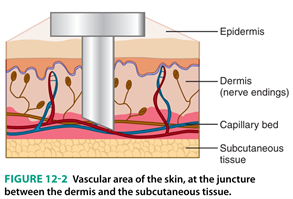Notes:
Feel Nga igpapa Drawing:
 CAPILLARY PUNCTURE EQUIPMENT
CAPILLARY PUNCTURE EQUIPMENT
Lancets/Incision Devices
Micro-Collection containers/microtubes
Microhematocrit Tubes and Sealant
CAPILLARY BLOOD GAS EQUIPMENT
CBG collection tubes
Stirrers
Magnet
Plastic Cups
Microscope Slides
Warming Devices
The following CLSI-recommended order of draw for capillary specimens takes clotting into consideration:
1. Blood gas specimen
2. Slides
3. EDTA specimens
4. Other additive specimens
5. Serum specimens
STEPS IN CAPILLARY PUNCTURE
Position the patient
Select the puncture site
Warm the site if applicable
Clean and air-dry the site
Prepare equipment
Grasp the finger or heel firmly
Position the lancet, puncture the site, and discard the lancet
Lower the finger or heel, and apply gentle pressure until a blood drop forms
Wipe away the first blood drop
Fill and Mix the Tubes/Containers in Order of Draw
Place gauze, apply pressure and elevate the site
Label and prepare specimens for handling and transportation
Check the site, and apply a bandage
Discard used materials, thank the patient, remove gloves, and sanitize the hands
STEPS IN HEELSTICK PUNCTURE
Position the patient
Select puncture site
Warm the site
Clean and air-dry the site
Prepare equipment
Grasp the heel firmly. Position the lancet, puncture the site, and discard the lancet
Lower the heel and apply gentle pressure until a blood drop forms
Wipe the first blood drop
Fill and mix the tubes/containers in order of draw
Place gauze, elevate the heel, and apply pressure
Label and prepare the specimen for handling and transport
Check the site. Note: do not apply a bandage
PREPARING BLOOD SMEAR
Perform capillary puncture
Wipe away the first blood
Touch a slide the next blood drop
Hold the blood drop slide between the thumb and forefinger of the nondominant hand or between the thumb and index finger pointing away from you. With the other hand, rest the second slide in front of the drop at an angle of approximately 30 degrees.
Pull the spreader slide back to the edge of the blood drop. Stop it as soon as it touches the drop, and allow the blood to spread along its width.
Push the spreader slide away from the drop in one smooth motion, carrying it the entire length and off the end of the blood drop slide
Place the drop of blood for the second smear on the spreader slide. Use the slide with the first smear as the spreader slide for the second smear and make it in the same manner as the first one.
Place gauze over the wound and ask the patient to apply pressure.
Label frosted blood slides by writing the patient information in pencil on the frosted area.
Allow the blood films to air-dry, and place them in a secondary container for transport.
Check puncture site and apply bandage.
Note: Do not apply a bandage to the infant.
Thank the patient, remove gloves, sanitize the hands, and transport the slides to the lab.